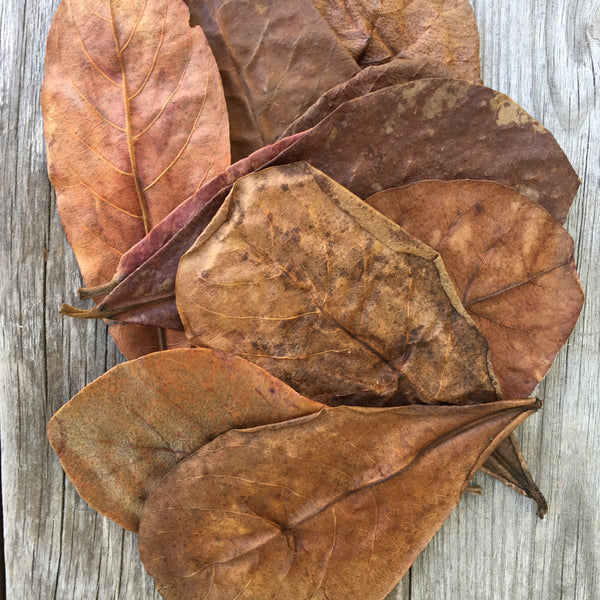- Continue Shopping
- Your Cart is Empty
As the leaves fall, the productivity rises
As we all know, the basis of many of our blackwater, botanical-style systems is...wait for it- LEAVES! They make up a huge percentage of the plant materials which accumulate in tropical streams and other bodies of water in these locales, and, as we know, are extremely important to the fishes which inhabit them, providing protection, food, and even physical territory.

What makes leaves fall off the trees in the first place? Well, it's simple- er, rather complex...but I suppose it's simple, too. Essentially, the tree "commands" leaves to fall off the tree, by creating specialized cells which appear where the leaf stem of the leaves meet the branches. Known as "abscission" cells. for word junkies, they actually have the same Latin root as the word "scissors", which, of course, implies that these cells are designed to make a cut!
And, in the tropical species of trees, the leaf drop is important to the surrounding environment. The nutrients are typically bound up in the leaves, so a regular release of leaves by the trees helps replenish the minerals and nutrients which are typically depleted from eons of leaching into the surrounding forests. And the rapid nutrient depletion, by the way, is why it's not healthy to burn tropical forests- the release of nutrients as a result of fire is so rapid, that the habitat cannot process it, and in essence, the nutrients are lost forever.

Now, interestingly enough, most tropical forest trees are classified as "evergreens", and don't have a specific seasonal leaf drop like the "deciduous" trees than many of us are more familiar with do...Rather, they replace their leaves gradually throughout the year as the leaves age and subsequently fall off the trees.
The implication here?
There is a more-or-less continuous "supply" of leaves falling off into the jungles and waterways in these habitats, which is why you'll see leaves at varying stages of decomposition in tropical streams. It's also why leaf litter banks may be almost "permanent" structures within some of these bodies of water!

And, for the fishes and other organisms which live in, around, and above the litter beds, there is a lot of potential food, which does vary somewhat between the "wet" and "dry" seasons and their accompanying water levels. The fishes tend to utilize the abundant mud, detritus, and epiphytic materials which accumulate in the leaf litter as food. During the dry seasons, when water levels are lower, this organic layer compensates for the shortage in other food resources.
During the higher water periods, there is a much greater amount of allochthonous input (remember that?) from the surrounding terrestrial environment in the form of insects, fruits, and other plant material. I suppose that, in our aquariums, it's pretty much always the "wet season", right? We tend to top off and replace decomposing leaves and botanical more-or-less continuously.

Now, of course, where is where I get into what I will call "speculative environmental biology!" What if we stopped replacing leaves and even lowered water levels or decreased water exchanges in our tanks to correspond to, for example, the Amazonian dry season (June to December)...And if you consider that many fishes tend to spawn in the "dry" season, concentrating in the shallow waters, could this have implications for breeding?

In fact, I further proffer that we need to look a lot deeper into the idea of environmental manipulation for the purpose of getting our fishes to be healthier, more colorful, and especially, to spawn. Now I know, the idea is nothing new on a "macro" level- we've been increasing and lowering temps in our aquariums, adjusting lighting levels, and tweaking stuff for a long time.

Killie keepers have played with this in drying and incubation periods in annual killifish eggs. However, I don't think we've been doing a lot of real hardcore manipulations...like adjusting water levels, increasing nutrient levels (ie; "pulsing" adding leaves and other botanicals), manipulating current, dissolved oxygen, food types, etc.

I think that there are so many different things that we can play with- and so many nuances that we can investigate and manipulate in our aquariums. I think that this could even add a new nuance to biotope aquarium simulation, such as creating an aquarium which simulates the "Preto da Eva River in Brazil in October", for example...with appropriate environmental conditions, such as water level, amounts of allochthonous material, etc.
The possibilities are endless here!

Obviously, there is much to learn, and of course, the bigger question that many will ask, "What is the advantage?"
That's part of the fun...we can play a hunch, but we won't know for certain until we really delve into this.
Who's in?
Stay curious. Stay engaged. Stay open-minded...
And Stay Wet.
Scott Fellman
Tannin Aquatics
2 Responses
Scott Fellman
Thanks! I tend to go “off the rails” a bit with this kind of free-thinking and speculation, but I think it’s important for us as hobbyists to push ourselves into different areas and get out of the “this is how we’ve always done it..” mindset… Looking forward to a lot of new ideas!
Lily Northover
Food for thought indeed. What a brilliant article, really enjoyed it.








Scott Fellman
Author